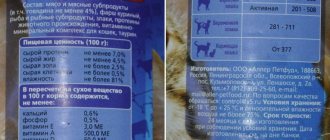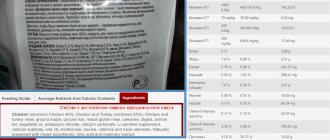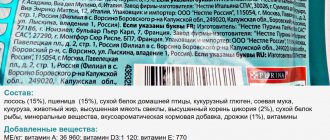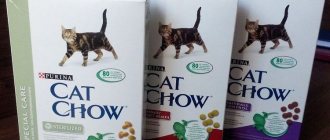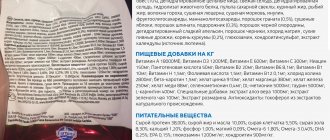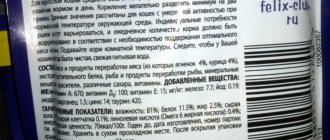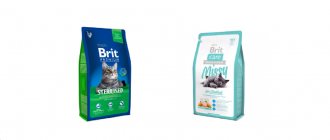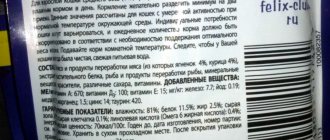Pets that suffer from various diseases require special care. In addition to treatment with veterinary medications, cats with special needs must be provided with an appropriate diet. The Hills brand, a joint American-Dutch company specializing in the development of veterinary cat food, has been solving this problem for decades.
Hill's high-quality dietary food for cats stimulates the functioning of certain internal organs and systems of the body. It helps the animal overcome painful symptoms and gives strength to recover and regain the lost quality of life. Veterinary medicine professionals who have solid experience and accurate understanding of the needs of domestic cats work on the creation of food formulas. Read the article about the Royal Canin veterinary diet.
Compound
In the process of producing ready-made food for cats, the manufacturer uses a large number of ingredients, namely:
- turkey or chicken fillet;
- vegetable protein like corn gluten;
- rice and corn;
- fats of animal origin;
- fish oil;
- vegetable fats;
- cultivated soybeans;
- tuna flour;
- products of the dairy industry.
Also among the ingredients are dried beet pulp, β-carotene, a small amount of cellulose, amino acids, vitamins and minerals.
Note! Ready-made food for four-legged friends contains natural preservatives, in particular rosemary.
Feed composition
According to quality standards, the main ingredient of a balanced medicinal food should be meat. This ingredient should be one of the first listed in the composition. By examining the packaging of any veterinary product from the brand’s line, for example, by analyzing Hills dietary cat food, you can understand that the recipe has an optimal protein content. In addition, the food formula is supplemented with vitamins, minerals, and essential fatty acids.
The sources of carbohydrates in the food from the Hills Diet for Cats line are high-quality grain crops and vegetables. Your pet will also receive essential micronutrients from fish oil, which play a critical role in maintaining brain and central nervous system health.
Medicinal feed
The Hill's prescription diet line of medicinal food for cats includes more than 10 varieties.
Such a diet should only be prescribed by a veterinarian, who takes into account the identified pathologies of the pet. It is also important to coordinate the frequency and continuation of feeding with a specialist. Medicinal food is used for feeding only during therapy and during the recovery period after illness. These products contain some elements in large quantities, which can harm the body of a healthy animal.
The manufacturer produces the following line of balanced diets for four-legged friends who suffer from kidney dysfunction and urological pathologies:
- SD is Hill's brand food, which is advisable to use in courses for the prevention or treatment of urinary tract pathologies.
- CD is recommended for use during the treatment of cystitis and urolithiasis.
- KD is a diet that veterinarians prescribe to their patients during the treatment of kidney diseases.
- GD is advisable to use in cases where chronic renal failure is combined with diseases of the heart muscle.
- LD is recommended for feeding four-legged friends suffering from liver failure.
- ID – food for cats diagnosed with pathologies of the digestive system.
- WD are ready-made diets that have a wide range of effects on the body of an animal suffering from constipation, colitis, and intestinal inflammation.
If your four-legged friend is overweight, various pathologies can develop. This is why it is so important to adjust your pet’s weight in a timely manner. The manufacturer produces products that are intended for feeding overweight cats.
- MD is an option ideal for furry purrs who suffer from obesity, and cats who have been diagnosed with an excess of glucose in the plasma.
- RD is a ready-made food for cats that are forced to adhere to a diet.
- Metabolic – helps speed up metabolism and weight loss.
- Metabolic + Urinary helps animals not only lose weight, but also cope with urolithiasis.
Line of other feeds:
- YD – used during the treatment of thyroid pathologies.
- JD is a ready-made diet that helps cope with joint diseases.
- TD is a ready-made food from a well-known brand, which veterinarians prescribe during the treatment of oral diseases.
- ZD is an ideal diet for four-legged friends with allergies.
“HILLS” CJSC “Valta Pet Products” www.valta.ru, www.hillspet.com
HILLS PRESCRIPTION DIET FELINE C/D
Prevention of urolithiasis (struvite).
Nutritional characteristics
(Comparison with Science Plan Feline Maintenance) Phosphorus - reduced content.
Magnesium - the content is significantly reduced, less than 20 mg/100 kcal. Promotes the formation of acidic urine pH. Indications
The nutritional characteristics of Prescription Diet Feline c/d allow it to be successfully used for urological syndrome in cats caused by the formation of struvite crystals.
OBJECTIVES - To avoid the formation of uroliths and crystals, which play a major role in the development of diseases of the lower urinary tract. Prescription Diet Feline c/d helps to avoid excessive intake of magnesium and phosphorus, and promotes the production of urine with normal acidity. This prevents the formation of struvite uroliths and crystals. Contraindications:
Kittens and pregnant cats.
The use of drugs that acidify urine pH. Cats with another type of urolithiasis (not struvite). Directions for use:
Prescription Diet Feline c/d (dry and canned) is capable of supporting an adult animal for a long time. Usually, any additives to it, especially drugs that increase the acidity of urine, are contraindicated. Individual needs may vary depending on the animal's breed, temperament, disease, season, environment, and stress factors.
HILL'S PRESCRIPTION DIET FELINE I/D
Treatment of gastrointestinal diseases in cats.
Nutritional characteristics
(Comparison with Science Plan Feline Maintenance) Protein - high digestibility Fat - reduced content, high digestibility Carbohydrates - high digestibility Soluble fiber - increased content Electrolytes - increased content
Indications
The nutritional characteristics of Prescription Diet Feline i/d allow it to be successfully used in the following cases: · Gastrointestinal diseases, including gastritis, enteritis, as well as during recovery after surgery on the gastrointestinal tract.
OBJECTIVES — To provide the animal with highly digestible food during restoration of normal gastrointestinal activity and recovery after surgery. It is necessary to feed during this period often, in small portions (3-6 times a day). · Exocrine pancreatic insufficiency. OBJECTIVES — To provide the animal with highly digestible food due to the reduced activity of pancreatic enzymes. · Acute pancreatitis without signs of hyperlipidemia. OBJECTIVES—To provide cats with a highly digestible diet (moderately reduced in fat) after an initial stage of acute pancreatitis without signs of hyperlipidaemia. Feed cats often, in small portions (3-6 times a day). · Colitis. OBJECTIVES - To provide the animal with adequate amounts of insoluble and soluble fiber. Insoluble fiber affects the transit time of feed through the intestine, and soluble fiber is broken down into short-chain fatty acids, which are used to nourish colonocytes and help restore normal microflora in the intestine. Contraindications
For sodium retention in the body.
Directions for use
Prescription Diet Feline i/d (dry and canned) is capable of supporting an adult animal for a long time. Any additives to it are contraindicated. Individual needs may vary depending on the animal's breed, temperament, disease, season, environment, and stress factors.
| HILLS PRESCRIPTION DIET FELINE L/D Treatment of liver diseases. Nutritional characteristics (Comparison with Science Plan Feline Maintenance) Protein - content reduced Arginine - content increased Sodium - content decreased Zinc - content increased Potassium - content increased L-Carnitine - added Promotes the formation of a less acidic urine pH. |
Indications
The nutritional characteristics of Prescription Diet Feline l/d allow it to be successfully used in the following cases: · Liver diseases.
OBJECTIVES - Reduce the metabolic load on the liver, inhibit further progression of liver damage, maintain and restore liver function. This is achieved by providing the animal with food rich in highly digestible carbohydrates, which reduces the need for gluconeogenesis. High-quality protein in the feed accelerates recovery, and appropriate levels of essential vitamins and minerals help normalize metabolism in the liver and body. Prescription Diet Feline l/d contains reduced sodium levels to control clinical signs associated with ascites. This food is designed for dietary feeding in liver diseases, including: hepatic lipidosis, bile duct inflammation, hepatocellular diseases, portosystemic shunts, hepatoencephalopathy, fibrotic hepatopathy, gallbladder disease and glucocorticoid-induced hepatopathy. · Liver lipidosis. OBJECTIVES - To facilitate normal fat transport and metabolism in the liver by appropriately enriching the feed with L-carnitine. · Hepatoencephalopathy. OBJECTIVES—To avoid or limit clinical signs of hepatoencephalopathy by reducing protein intake and optimizing dietary levels of branched-chain and aromatic amino acids, which help reduce blood concentrations of urea and other nitrogen-containing metabolites. Contraindicated
for kittens (long-term feeding).
Pregnant cats With hyperlipidemia. Directions for use
Prescription Diet Feline l/d can support an adult animal for a long time. Any additives to it are contraindicated. Individual needs may vary depending on the animal's breed, temperament, disease, season, environment, and stress factors.
HILLS PRESCRIPTION DIET FELINE S/D
Treatment of urolithiasis (struvite).
Nutritional characteristics
(Comparison with Science Plan Feline Maintenance) Energy - increased Phosphorus and calcium - decreased Magnesium - less than 20 mg/100 kcal Sodium - increased Promotes acidic urine pH.
Indications
The nutritional characteristics of Prescription Diet Feline s/d allow it to be successfully used in the following cases: · Struvite urolithiasis.
OBJECTIVES—Avoid excessive intake and urinary excretion of magnesium and phosphorus by using feeds with high energy content (to reduce feed intake) and controlled levels of magnesium and phosphorus. It is also necessary to increase the volume of urine excreted and maintain normal urine acidity. The acidic pH value of urine increases the solubility of struvite uroliths and crystals. In case of concomitant infection, antibiotic therapy should be used. · Diseases of the lower urinary tract (feline urological syndrome). OBJECTIVES - Dissolution of struvite crystals and uroliths in the urinary tract, by reducing the concentration of struvite components in the urine and maintaining normal urine acidity. After the initial period of using Feline s/d (2-3 months), disease prevention can be achieved by feeding Prescription Diet Feline s/d. In case of relapse when using only one Feline s/d, it is necessary to return to using Feline s/d food. But due to the excess salt content in Feline s/d food, its long-term use is not recommended. Contraindications
Kittens and pregnant cats Using drugs that increase urine acidity Cats with other types of urolithiasis (not struvite) Kidney disease, hyperkalemia and metabolic acidosis Diseases of the cardiovascular system, as it contains a lot of sodium Feeding for more than 6 months without regular status checks pH
Method of use
Prescription Diet Feline s/d is not recommended for long-term consumption unless relapses of urolithiasis occur when using Feline c/d. With long-term use, it is necessary to periodically evaluate renal function, plasma potassium content and acid-base balance. Any additives to it, especially drugs that increase the acidity of urine, are contraindicated.
HILLS PRESCRIPTION DIET FELINE K/D
Treatment of kidney diseases, ICD (oxalates, urates).
NUTRITIONAL FEATURES (Comparison with Science Plan Feline Maintenance) Protein - reduced Non-protein calories - increased Phosphorus - reduced Sodium - reduced Soluble fiber - increased Omega-3 fatty acids - added Magnesium - less than 20 mg/100 kcal. Promotes the formation of a less acidic urine pH. INDICATIONS The nutritional characteristics of Prescription Diet Feline k/d allow it to be successfully used in the following cases: · Kidney diseases. OBJECTIVES: Reduce retention of nitrogen-containing metabolites in the body, reduce phosphorus levels and signs of hyperparathyroidism, which helps prevent systemic hypertension and metabolic acidosis. This is achieved by the fact that this food has a reduced content of protein, phosphorus and sodium, and an increased content of soluble fiber and omega-3 fatty acids. · Early stages of heart disease. OBJECTIVES—Reduce sodium intake to help prevent ascites and systemic hypertension. Prescription Diet Feline k/d contains reduced sodium levels. · Prevention of the formation of urate and cystine uroliths. OBJECTIVES - Prevent the formation of urate and cystine uroliths and crystals. This food contains reduced levels of protein and minerals, which reduces the concentration of urate and cystine in the urine. CONTRAINDICATIONS: Kittens and pregnant cats. With struvite urolithiasis. With a lack of sodium in the body. HOW TO USE Prescription Diet Feline k/d food is capable of supporting an adult animal for a long time. Any additives to it are contraindicated. Individual needs may vary depending on the animal's breed, temperament, disease, season, environment, and stress factors.
HILLS PRESCRIPTION DIET FELINE W/D
Treatment of diabetes, constipation, colitis.
NUTRITIONAL CHARACTERISTICS (Comparison with Science Plan Feline Maintenance) Energy - reduced L-Carnitine - added Fat - reduced Magnesium - close to daily value Fiber - increased Promotes acidic urine pH. INDICATIONS The nutritional characteristics of Prescription Diet Feline w/d allow it to be successfully used in the following cases: · Prevention of obesity in adult cats that are inactive, neutered or overweight and prone to obesity. Also to prevent relapses of obesity in animals that have successfully completed a weight loss program using Prescription Diet Feline r/d food. OBJECTIVES - To provide a low-energy, fiber-rich feed specifically balanced for inactive adult animals. Supplementing with L-carnitine to adequate levels helps limit fat storage and maintain optimal lean body mass. · Diabetes mellitus (for patients with normal weight and no other diseases). OBJECTIVES—Increase fiber intake to minimize fluctuations in blood glucose levels, thereby reducing insulin dosage. · Hyperlipidemia. GOALS - Reduce fat intake and increase fiber intake. · Colitis. GOALS - Reduce fat intake and increase fiber intake. · Constipation. OBJECTIVES - Increase fiber intake to enhance intestinal motility. · Preventing the formation of struvite in cats prone to obesity. OBJECTIVES - Providing feed containing a reduced level of struvite-forming elements and promoting the formation of an acidic urine pH. CONTRAINDICATIONS: Kittens and pregnant cats. When using drugs that increase urine acidity. Exhaustion or weight loss. When the body is dehydrated Azotemia
HILLS PRESCRIPTION DIET FELINE X/D
NUTRITIONAL CHARACTERISTICS (Comparison with Science Plan Feline Maintenance) Phosphorus - reduced Calcium - reduced Potassium Citrate - added Promotes a less acidic urine pH. INDICATIONS The nutritional characteristics of Prescription Diet Feline x/d allow it to be used successfully for feline urological syndrome caused by the formation of oxalate crystals. OBJECTIVES—Prevent the formation of oxalate crystals and urolith formation, which contribute to the development of lower urinary tract disease in cats. Prescription Diet Feline x/d prevents excess intake of calcium, vitamin D and sodium, and contains potassium citrate, soluble fiber and adequate levels of pyridoxine. The food promotes the formation of a less acidic urine pH. These nutritional characteristics avoid the formation of calcium oxalate crystals and uroliths. CONTRAINDICATIONS 1. Kittens and pregnant cats 2. Cats with struvite type of urolithiasis INGREDIENTS Beef, liver, rice, rice flour, corn gluten, FibrimR1260 (source of soluble fiber), vegetable oil, dry yeast, vegetable gum, potassium citrate. Choline chloride, calcium carbonate, dicalcium phosphate, taurine, DL-methionine, calcium sulfate, iron oxide, magnesium oxide, iodized salt, zinc oxide, ferrous sulfate, copper sulfate, manganese oxide, sodium selenite, calcium iodate, D-activated animal sterols (sources of vitamin D3), vitamin E, thiamine, niacin, calcium pantothenate, pyridoxine hydrochloride, riboflavin, folic acid, biotin, vitamin B12. FibrimR is a registered trademark of Protein Technologies International, Inc. HOW TO USE Prescription Diet Feline x/d is capable of supporting an adult animal for a long time. Any additives to it are contraindicated. Individual needs may vary depending on the animal's breed, temperament, disease, season, environment, and stress factors.
HILLS PRESCRIPTION DIET FELINE T/D
NUTRITIONAL CHARACTERISTICS (Comparison with Science Plan Feline Maintenance) Energy - reduced Fiber - increased Promotes acidic urine pH. MECHANICAL CHARACTERISTICS The food contains fibers that do not damage tooth enamel. INDICATIONS The nutritional and mechanical characteristics of Prescription Diet Feline t/d allow it to be successfully used in the following cases: · Reducing the deposition of plaque and tartar on teeth and reducing the coloration of teeth in adult cats. OBJECTIVES - Providing animals with special elastic food, which allows teeth to penetrate into pieces of food and clean themselves. · Reduction of bad breath in adult cats caused by diseases of the teeth and oral cavity. OBJECTIVES - To reduce malodor by feeding a diet that prevents plaque deposits. · Treatment of diseases that respond to the level of fiber in the diet: diabetes, colitis, constipation (see Prescription Diet Feline w/d). OBJECTIVES—Use a feed that contains sufficient levels of fiber to control the above diseases. IMPORTANT TO REMEMBER: Prescription Diet Feline t/d works more effectively with clean teeth. Therefore, it is recommended that before starting to use these foods, consult a doctor to have your teeth checked and cleaned of tartar. Prescription Diet Feline t/d can be used as a stand-alone complete food. Prescription Diet Feline t/d should not be soaked before feeding. Adding water sharply reduces the therapeutic effectiveness of this feed. Prescription Diet Feline t/d does not contain abrasives or active chemical compounds. In addition to feeding Prescription Diet Feline t/d, you can also brush your cat's teeth with a special toothpaste. CONTRAINDICATIONS For dogs, kittens and pregnant cats. Cats with severe periodontal disease. HOW TO USE Prescription Diet Feline t/d food is capable of supporting an adult animal for a long time. Usually any additives to it are contraindicated. Individual needs may vary depending on the animal's breed, temperament, disease, season, environment, and stress factors. The amounts listed below can only serve as a starting point and require further refinement to maintain the animal's optimal weight. INGREDIENTS Chicken, rice, ground corn, corn gluten, fiber powder, animal fat, vegetable oil, chicken peptides, calcium sulfate, potassium chloride, choline chloride, iodized salt, DL-methionine, taurine, ferrous sulfate, zinc oxide, copper sulfate , manganese oxide, sodium selenite, calcium iodate, vitamin A, vitamin D, vitamin E, thiamine, calcium pantothenate, riboflavin, pyridoxine hydrochloride, folic acid, biotin, vitamin B12. Contains EU approved antioxidant.
| HILLS PRESCRIPTION DIET FELINE R/D NUTRITIONAL CHARACTERISTICS (Comparison with Science Plan Feline Maintenance) Energy - reduced Fat - reduced Fiber - increased Magnesium - close to daily value L-Carnitine - added Promotes acidic urine pH. |
INDICATIONS The nutritional characteristics of Prescription Diet Feline r/d allow it to be successfully used in the following cases: · Obese adult cats. OBJECTIVES - Reduce animal calorie intake and increase feed volume with indigestible fiber to reduce hunger. Additional administration of L-carnitine ensures an adequate level of fat metabolism. · Obese cats with diseases affecting dietary fiber levels: see indications for Prescription Diet Feline w/d. OBJECTIVES - Using a high fiber, low fat and low calorie diet to reduce the animal's weight and help treat disease. CONTRAINDICATIONS Kittens and pregnant cats Exhaustion of animals When using drugs that increase the acidity of urine When dehydration of the body INGREDIENTS Liver, pork, corn, cellulose, corn gluten, chicken peptides, vegetable oil, calcium sulfate, dicalcium phosphate, calcium carbonate, potassium chloride, taurine, iodized salt, iron oxide, choline chloride, L-carnitine, zinc oxide, ferrous sulfate, copper sulfate, manganese oxide, sodium selenite, calcium iodate, D-activated animal sterols (sources of vitamin D3), vitamin E, thiamine, niacin, calcium pantothenate , pyridoxine hydrochloride, riboflavin, folic acid, biotin, vitamin B12. METHOD OF APPLICATION FOR THE TREATMENT OF OBESITY WHEN DETERMINING THE REQUIRED QUANTITY OF FEED, BE GUIDED BY THE IDEAL WEIGHT OF THE ANIMAL, NOT THE ONE IT HAS AT THE CURRENT MOMENT! The recommended amounts provide the animal with only 70% of the required energy. You should not let your cat lose weight too quickly. The diet must provide at least 60% of the energy needed to maintain ideal weight, otherwise there is a risk of hepatic lipidosis. The best effect can be achieved only with constant monitoring of food intake. After reaching optimal weight, the animal should be switched to Prescription Diet Feline w/d.
| HILLS PRESCRIPTION DIET FELINE P/D NUTRITIONAL FEATURES (Comparison with Science Plan Feline Maintenance) Protein - increased Energy - increased Minerals and Electrolytes - increased |
INDICATIONS The nutritional characteristics of Prescription Diet Feline p/d allow it to be successfully used in the following cases: · Recovery of cats after surgery, after exhaustion, after fractures, etc. OBJECTIVES - To provide animals with food with increased levels of energy and nutrients to promote faster recovery. · Correcting the consequences of improper feeding of cats and dogs. OBJECTIVES - To provide animals with food with increased protein, energy and other nutrients, which helps correct the deficiency of certain substances in the body. Prescription Diet Feline p/d is recommended for the recovery of animals after acute and chronic diseases that lead to exhaustion of animals. This includes trauma, sepsis, cancer, parasites, etc. Feline p/d can be used for cats of all ages. In the initial stages of recovery, preliminary use of Prescription Diet Canine/Feline a/d is recommended. · Skin diseases of a non-allergic nature. OBJECTIVES - To provide animals with feed with the correct balance of nutrients to improve the functioning of skin tissue. · Improvement of reproductive function and growth of animals. OBJECTIVES - To provide animals with feed that contains the correct balance of nutrients and energy to optimize growth, pregnancy and lactation. · Bone diseases. OBJECTIVES - To provide animals with feed that contains the correct balance of nutrients for normal bone formation. In this case, additional mineral fertilizers cannot be used. CONTRAINDICATIONS For obese cats. When using drugs that increase urine acidity. Animals with kidney, liver or heart disease, as the food contains increased levels of protein and sodium. INGREDIENTS Beef, liver, chicken, soybean meal, corn gluten, animal fat, corn, dried whole egg, chicken peptides, calcium sulfate, dicalcium phosphate, iodized salt, calcium carbonate, potassium chloride, taurine, iron oxide, zinc oxide, sulfate iron, copper sulfate, manganese oxide, calcium iodate, sodium selenite, D-activated animal sterols (sources of vitamin D3), vitamin E, thiamine, niacin, calcium pantothenate, pyridoxine hydrochloride, riboflavin, folic acid, biotin, vitamin B12. METHOD OF APPLICATION The body's needs for nutrients during the period of recovery after serious illnesses strongly depend on the general condition and weakness of the animal. Prescription Diet Feline p/d is recommended to be consumed in maintenance amounts at the beginning and then feed intake must be increased to achieve optimal weight. Prescription Diet Feline p/d also fully meets the needs of growing kittens and pregnant and lactating cats.
HILLS PRESCRIPTION DIET FELINE H/D
NUTRITIONAL CHARACTERISTICS (Comparison with Science Plan Feline Maintenance) Sodium - reduced Taurine - increased Magnesium - less than 20 mg/100 kcal. Promotes the formation of acidic urine pH. INDICATIONS The nutritional characteristics of Prescription Diet Feline h/d allow it to be successfully used in the following cases: · Congestive heart disorders. OBJECTIVES—Reduce sodium intake in cats with congestive heart disease to help control clinical signs associated with sodium and fluid retention. Prescription Diet Feline h/d contains reduced sodium levels. · Hypertension and ascites. OBJECTIVES—Reduce sodium intake in cats with liver and kidney disease to help control clinical signs associated with sodium and fluid retention. Prescription Diet Feline h/d contains reduced sodium levels. CONTRAINDICATIONS: Kittens and pregnant cats. With excessive excretion of sodium from the body (with vomiting and diarrhea). When using drugs that increase urine acidity. INGREDIENTS Beef, liver, corn, chicken meat, animal fat, cellulose, chicken peptides, calcium sulfate, potassium chloride, taurine, iron oxide, zinc oxide, ferrous sulfate, copper sulfate, manganese oxide, sodium selenite, calcium iodate, D-activated animal sterols (sources of vitamin D3), vitamin E, thiamine, niacin, calcium pantothenate, pyridoxine hydrochloride, riboflavin, folic acid, biotin, vitamin B12. HOW TO USE Prescription Diet Feline h/d is capable of supporting an adult animal for a long time. Any additives to it are contraindicated. Individual needs may vary depending on the animal's breed, temperament, disease, season, environment, and stress factors. The amounts listed below can only serve as a starting point and require further refinement to maintain the animal's optimal weight.
HILLS PRESCRIPTION DIET FELINE G/D
NUTRITIONAL CHARACTERISTICS (Comparison with Science Plan Feline Maintenance) Protein - reduced content Non-protein calories - increased content. Fiber - increased content Phosphorus - decreased Omega-3 fatty acids - added L-Carnitine - added Promotes the formation of a less acidic urine pH. INDICATIONS The nutritional characteristics of Prescription Diet Feline g/d allow it to be successfully used in the treatment of kidney diseases at an early stage. OBJECTIVES—Reduce the formation and excretion of nitrogen-containing metabolites, and prevent hyperphosphatoemia to control glomerular hypertension and metabolic acidosis. This is achieved by the reduced content of protein and phosphorus in this feed, as well as the additional introduction of omega-3 fatty acids into its composition. INGREDIENTS Rice, corn gluten, chicken and turkey, animal fat, soybean hulls, corn, chicken and turkey peptides, choline chloride, potassium citrate, flaxseed, potassium chloride, dried yeast, salt, calcium sulfate, DL-methionine, L-carnitine, taurine, zinc oxide, ferrous sulfate, manganese oxide, copper sulfate, calcium iodate, sodium selenite, vitamin A, D-activated animal sterols (sources of vitamin D3), vitamin E, thiamine, niacin, calcium pantothenate, pyridoxine hydrochloride , riboflavin, folic acid, biotin, vitamin B12, antioxidant. CONTRAINDICATIONS The food is not recommended for kittens and pregnant cats. HOW TO USE Prescription Diet Feline g/d is capable of supporting an adult aging animal (over 6 years old) for a long time. Any additives to it are contraindicated. Individual needs may vary depending on the animal's breed, temperament, disease, season, environment, and stress factors.
HILLS PRESCRIPTION DIET FELINE D/D
NUTRITIONAL FEATURES (Comparison with Science Plan Feline Maintenance) Protein - Sources include lamb and rice only. Carbohydrates - the only source is rice Magnesium - less than 20 mg/100 kcal. Promotes the formation of acidic urine pH. INDICATIONS The nutritional characteristics of Prescription Diet Feline d/d allow it to be successfully used in the following cases: · Treatment of cats with dermatological and gastrointestinal signs of food allergies or food intolerance. OBJECTIVES—Eliminating ingredients that cause food allergies or intolerances and feeding highly digestible foods containing novel ingredients. New ingredients should not be previously used in the diet of a sick animal. · Treatment of non-allergic skin diseases. OBJECTIVES - To provide the animal with a properly balanced diet to improve the functioning of skin tissue. INGREDIENTS Lamb meat, lamb liver, rice, cellulose powder, calcium carbonate, potassium chloride, calcium sulfate, iodized salt, taurine, iron oxide, zinc oxide, ferrous sulfate, copper sulfate, manganese oxide, sodium selenite, calcium iodate, D-activated animal sterols (sources of vitamin D3), vitamin E, thiamine, niacin, calcium pantothenate, pyridoxine hydrochloride, riboflavin, folic acid, biotin, vitamin B12. CONTRAINDICATIONS: Kittens and pregnant cats. When using drugs that acidify urine pH. HOW TO USE Prescription Diet Feline d/d food is capable of supporting an adult animal for a long time. Usually, any additives to it, especially drugs that increase the acidity of urine, are contraindicated. In terms of its characteristics, the food differs quite sharply from the usual products for cats. Therefore, to prevent gastric disorders, you need to gradually transfer the animal to Feline d/d. The proportion of Feline d/d in the diet should gradually increase from 25% to 100% over 7-10 days. Individual needs may vary depending on the animal's breed, temperament, disease, season, environment, and stress factors.
Food for daily nutrition
The manufacturer of the Hills brand also took care of producing the basic diet for cats. Below you can find a description of this line.
- Hill's Science Plan is a ready-made cat food that can be used to feed healthy furry cats.
- Nature's Best is a diet containing a large number of useful elements. There are no ingredients that can cause an allergic reaction.
- Ideal Balance is a balanced ready-made food that contains a small amount of brown rice.
Grain-free food is poorly absorbed by the animal's body and can cause constipation. If the basis of your pet's menu is dry food, it is important to systematically pamper your furry purr with wet canned food.
For sterilized cats and cats that have undergone castration
After the cat has undergone sterilization or castration, it is worth transferring it to a special diet, since the pet after surgery needs a small amount of fats and proteins. The manufacturer of a well-known brand produces food for this category of four-legged friends. Hill's Young Adult Neutered cat food is available in the form of dry kibble, mousse or meat kibble. Veterinarians often prescribe this ready-made diet for pets.
Hypoallergenic food
In the event of a serious allergic reaction, it is important to transfer your pet to a special diet. Often, for this purpose, veterinarians prescribe a ready-made diet called Nature's Best, which does not contain products such as corn, chicken and rice that provoke allergies.
Hill's for sedentary cats
Hill's Science Plan Indoor Cat Adult is the ideal food for four-legged friends who spend most of their time lying down. Such couch potatoes are prone to obesity. Low-calorie food will help avoid weight problems. The animal's coat will remain silky.
Hill's Prescription Diet cat food reviews
Since Hill's food is very common, there are many reviews about it on the Internet. We've shared a few new ones we found below.
Customer Reviews
Marina writes:
This food was prescribed to us after an exacerbation of urolithiasis in a cat. We have been buying it for several years now, the cat eats it with great pleasure, and the attacks of the disease have subsided. The optimal size of the granules, the taste with chicken is what the cat likes best.
Victoria writes:
My cat is 14 years old. And 4 years ago, serious kidney problems began. I’ll say right away that the problems were not related to kidney stones (struvite). The pelvis in the kidneys began to collapse. Treatment at the veterinary clinic did not give lasting results. I just started surfing the Internet and found this food. The cat only eats it. His kidneys don't bother him anymore.
Ekaterina writes:
Excellent food! My picky eater eats it just fine. She was diagnosed with diabetes 2 months ago and immediately started feeding the cat this food + RK Diabetic liquid food. I was injected with insulin for 10 days and that’s it, my sugar returned to normal, I think that the food played a role in the treatment regimen.
Manufacturer
Hill's Prescription Diet range was developed by veterinarian Mark Morris. This man passionately loved animals and believed that they needed to be looked after in the same way as one’s own children - carefully and hourly, paying special attention to nutrition.
The turning point was a meeting with a blind guide dog: the dog had a serious kidney disease, from which the animal suffered greatly, and its owner turned to a veterinarian for help.
Morris, realizing that the animal feed available at that time was unbalanced (contained too much phosphorus), decided to independently develop food - not only tasty and nutritious, but also healthy.
Morris was joined by his wife Louise. The food was prepared in the basement of our own house and offered to all friends and acquaintances. The first batches were stored for a short time; a little later Morris began canning food.
In 1948, the first contract was concluded with the Hill Packing Company (Kansas), and in 1951 the doctor was able to open his own laboratory. In 1968, they began producing food for cats.
Today, Hill's food is available in 86 countries around the world, and owners involve both veterinarians and nutritionists in their work.
Negative reviews
Nadyushkaaa
In search of the best diet for my pet, I bought a bunch of different foods for her to try. Since I had her eat dry food from Hills for a certain time, naturally, I wanted to pick her up liquid food from the same brand. My cat's breed is Scottish Fold. She did not like this food at all. She didn't eat it. Considering how much she loves liquid food, and she only took a couple of bites of this one, it's very sad. At first I thought - maybe spoiled? But no, the smell is normal, and so is the appearance. Expiration date is ok. The food comes out like a pate, only molded into pieces; if you press it with a spoon, it will easily turn into mush, that is, it is not “rubbery.” Some layers or additives are noticeable in the pieces; it doesn’t look very nice. The same situation happened with this food, but with the taste of “chicken”. I didn’t try to give my cat any more spiders from this company.
The photo is a direct image to the above review.
Elnombre
The sterilized pussy with problems on the previous dry food began to gain weight, and besides, she was somewhat tired of it. I decided to try changing the food, the veterinarian advised Hills. Murka attacked him like crazy, ate her fill, and asked for more. The next day there was blood in the stool. It’s good that she went to the toilet in the house because of the frost. They stopped giving it, but she refused to eat her ProPlan for a couple of days and turned the house over in search of Hills. I tried to feed the food I had already bought to my second cat, who lives at a different address and has no problems, but she ate about five pellets and didn’t want any more.
Have a question?
Kormclub
Reviews of pet food and products
Ask a Question
If you have questions about food or suggestions regarding the operation of our website, write to us using the special form
We would love to hear from veterinarians and customers about Hill's food. When we receive product reviews, we will definitely post them in this section.
Daily feed requirements
On the packaging, the manufacturer indicated approximate serving sizes. The owner should take into account that all animals are different. The dosage of food is selected individually, based on the condition and needs of the pet.
| Weight, kg | Portion, g |
| 2 | 30-40 |
| 3 | 40-55 |
| 4 | 50-70 |
| 5 | 60-80 |
| 6 | 65-90 |
| 7 or more | 90 and further for each kg of weight add 12 g of feed |
General characteristics of the feed
Hill's company produces food for regular and therapeutic use. She divides them according to the pet's age, weight, activity and other characteristics. The range includes dry and wet products.
Manufacturer
The company's head office is located in the USA; food is also produced in Holland (Netherlands). Hill's Pet Nutrition company appeared in Russia in 1995. The representative office is located at: Moscow, st. Krylatskaya, 17/1, Krylatsky Hills business park. For all citizens of the Russian Federation there is a free hotline 8 (800) 200-11-11, where you will be advised on any issue of interest. Official website https://www.hillspet.ru.
Feed class
The company compares food with the super premium class, but some experts prefer to classify Hills as premium.
Read the article about premium food for kittens.
Advantages and disadvantages of Hill's food
Pros of Hill's food:
- availability;
- acceptable price;
- rich assortment;
- carefully selected composition.
The negative points include:
- low fiber content in feed;
- a large number of plant components, including vegetable protein, which can affect weight gain and the health of the pet;
- lack of composition percentage on the packaging.
